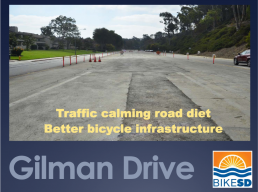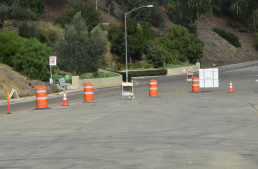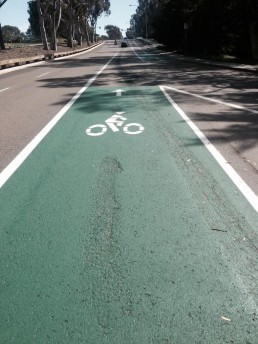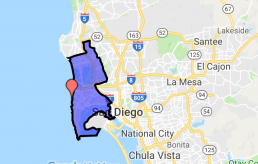Gilman Drive (La Jolla) buffered bike lane update

A four-lane road, Gilman Drive in La Jolla near the Univ. of California San Diego (UCSD), recently had new sewer lines installed. A stretch of this newly-repaved road was mere weeks away from getting re-striped when BikeSD mobilized to have the speed limit reduced and buffered bike lanes added.
BikeSD Executive Director Judi Tentor quickly assembled a Powerpoint and made a presentation to the University City Planning Group (UCPG) to show the many ways a road diet would improve the Gilman Drive corridor for all users. The Planning Group was enthusiastic about everything in Judi's presentation, though UCSD felt it could only contribute improved lane striping (in the form of buffered bike lanes rather than a full lane/parking removal as part of their sewer line replacement.) Still, it was the most suppportive community planning group reaction Judi ever attended.
After the presentation at UCPG, BikeSD received tentative support for a change of striping from staff at UCSD. So BikeSD worked with San Diego city staff engineer Brian Genovese to get revised striping plans for Gilman Drive that include new buffered bike lanes. These drawings were completed in early December and sent to UCSD for use in the university's Gilman Drive re-striping coming later this month. BikeSD and all the UC area cyclists are hopeful about seeing this improved striping get used when UCSD closes up the sewer line project.
What remains, however, is a full set of safety improvements for bikes and scooters along the Gilman Dr corridor. In principle, UCSD says it supports narrowing the lanes, reducing traffic speeds, and a fully protected bike facility along Gilman Drive. It will be interesting to see whether this will translate to future UCSD explicit calls for making the most of this corridor. BikeSD looks forward to partnering with UCSD, the UCPG, and CalTrans in expanding safety and access for all users along the entire Gilman Dr. corridor.
Is it time to ditch the phrase "Road Diet"?
A four-lane road, Gilman Drive in La Jolla near the Univ. of California San Diego (UCSD), recently had new sewer lines installed. A stretch of this newly-repaved road was three weeks away from getting re-striped when BikeSD mobilized to have the speed limit reduced and buffered bike lanes added.
BikeSD had tentative support for this change of striping from staff at UCSD. But after BikeSD's executive director presented plans for a road diet to the local community advisory group, UCSD was upset. They felt BikeSD had pulled a fast one on them by switching from a “re-striping” to a “road diet.” They weren't sure they could or would support a "road diet" on Gilman Drive.
UCSD's reaction isn't surprising to road safety advocates. Very often, when average people — car drivers — hear the phrase "road diet," they have negative reactions. The word "diet" means reducing and restricting. A traditional diet may reduce carbs; a road diet reduces cars. A traditional diet may squeeze down your waistline; a road diet squeezes the room around your car.
While notions like reducing cars and squeezing the roadway appeal to bike and safety advocates, these phrases have no positive connotation to people on a community boards, traffic engineers, or average folks who depend on driving. Simply put: when advocates use the phrase "road diet" we conjure up the wrong imagery in the ears of our listeners.
On top of that, everyone knows: "Diets don't work."
So maybe it's time to ditch the phrase "road diet." And time to ditch the phrase "traffic calming" as well. ("Traffic calming" sounds like a plan to have drivers just settle in and wait out the slow snarl of traffic while meditating. No driver wants to hear about how a street design will slow down, calm, or involve "traffic.")
It's time to adopt better phrasing for this important work.
I'd like to propose a new framework and term: M.O.S.T.
Mobility-
Oriented
Safety
Treatment
We all want to get the MOST out of our roadways.
Just about every element of a road diet is also a treatment to expand the use and users of a road. A roundabout reduces the need for stop signs, allowing better flow through intersections for both cars and bicycles. Buffered mid-speed lanes (aka bike lanes) increase the capacity of a street by accommodating bikes, scooters, and congestion-reducing methods of getting down the street. Bulbouts and curb ramps make traveling on foot or by wheelchair more pleasant and safe, thereby increasing the likelihood for walking (fewer cars), reducing the need for paratransit vehicles (fewer vans), shortening pedestrian crossing times for people at intersections, etc.
Almost every road diet element is also safety-enhancing step. The problem is that the phrase "road diet" fails to capture any notion of increasing safety. 'Diet' inherently sounds like less rather than more. In reality, we're talking about enhancements, not reductions.
MOST is about getting the most out of our road space. MOST street design focuses on maximizing the number of ways people can use a street. Roads which get the MOST design are safer than traditional road layouts. More importantly, a MOST street serves the greatest amount of people -- not just one type of user (typically cars). When we pitch to audiences about bringing the MOST to a street design, we're talking about expanding the road to its greatest, safest capacity.
MOST, as a phrase and a framework, reminds everyone (car drivers, walkers, folks, bikers, scooter users, the disabled, parents with strollers...) that we share a common goal: getting the most value from our shared street space. Who wouldn't want the MOST for their roads?
Gilman Drive bike facility (La Jolla)
BikeSD Executive Director Judi Tentor will be speaking at the University Community's Plan Update Subcommittee in an effort to get striping done in the Gilman Dr. Sewer Line Replacement segment to create an enhanced bicycle facility. Meeting starts at 6pm on November 13, 2018. Judi is on the agenda at 8pm. Location: Alexandria Building, 10300 Campus Pointe Dr., 2nd floor, La Jolla.
Photos from the Flickr series here: https://www.flickr.com/photos/bicycle_dreaming/sets/72157697610916390
Want La Jolla to be More Bike Friendly?
If you want La Jolla to be more be more bike friendly, today is your chance to speak up. Councilmember Sherri Lightner's representative, Erin Demorest, is seeking input on how to make La Jolla more bike friendly.
Demorest also announced that Mayor Bob Filner has created a bike program initiative, and is seeking input on needed improvements to bicycle infrastructure, such as locations to place “sharrows” (arrows that remind motorists to share the road with cyclists), potential locations for public bike corrals, missing or faded bike lane markers and potential sites for new bike paths.
Suggestions can be e-mailed to: edemorest@sandiego.gov
We've sent in a copy of the BikeSD Vision Map that many of you have steadily been offering suggestions to. We're continuing to update the map with the all the feedback we've been receiving, so keep them coming.
If you want to take on a more active citizenry role in La Jolla, please attend the La Jolla Community Planning Association meeting tonight which will be held at the La Jolla Rec Center, 615 Prospect St., La Jolla starting at 6pm.
Tonight: District 2 Bicycle/Pedestrian Advisory Committee Meeting; Thursday: Ride with Councilmember Faulconer
This month's District 2 bicycle/pedestrian advisory committee meeting will be held at St. Peter's Church on Sunset Cliffs Blvd. at 7pm. The embedded map below marks the boundaries of District 2 in San Diego and also marks the meeting location. If you live within the District boundaries*, you are encouraged to attend to discuss how District 2 can become more bicycle friendly.
View District 2 (San Diego) in a larger map
This Thursday (October 18th) District 2 Councilmember Kevin Faulconer and his representative, Michael Patton, will join District 2 residents on a bicycle ride. According to Nicole Burgess who heads the District 2 bicycle/pedestrian advisory committee, the purpose of the ride will be to bring awareness for the need of safer bike routes to and from schools. The ride meeting location is at 1pm by the Dana Middle School bike racks. The ride will head to People's and Roberto's for lunch.
* the map will be effective in December 2012 after the election.




